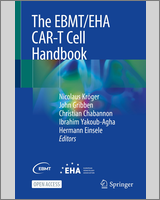A common and challenging side effect associated with CAR-T cell therapy is immune cell-associated neurotoxicity syndrome (ICANS), which occurs in 20–60% of patients, of whom 12–30% have severe (≥ grade 3) symptoms.
The underlying mechanism driving the syndrome is not fully understood, but there is evidence for the release of inflammatory cytokines secreted by macrophages and monocytes, increasing vascular permeability and endothelial activation and leading to blood–brain barrier breakdown. ICANS is not thought to be directly mediated by CAR-T cells themselves.
Risk factors for ICANS include high disease burden, older age, and the specific CAR-T product.
The onset of ICANS occurs (on average) approximately 5 days following CAR-T cell infusion and sometimes occurs concurrently with or shortly after cytokine release syndrome (CRS). However, in approximately 10% of patients, ICANS presents more than 3 weeks after CAR-T cell infusion.
Symptoms of ICANS are variable and can initially be vague. Patients experience mild tremor and confusion, which can then proceed to agitation, seizures, and cerebral oedema. A prominent and early feature of ICANS is hesitancy of speech and deterioration in handwriting, which can progress to aphasia with both expressive and receptive components, whereby the patient is alert but mute. The most devastating consequence of ICANS is the occurrence of status epilepticus, fatal cerebral oedema and occasionally intracerebral haemorrhage.
ICANS is a clinical diagnosis—brain MRI and CSF evaluation are rarely helpful but can be used to rule out alternative diagnoses, e.g., CNS infection. The EEG recording can be normal but can also demonstrate a pattern of variable abnormalities, including nonconvulsive status epilepticus.
Most cases spontaneously resolve, often with supportive care and early intervention with corticosteroid therapy.
All patients should be proactively monitored for ICANS twice daily to assess subtle changes in cognition using the 10-point Immune Effector Cell Encephalopathy (ICE) score (Table ), which evaluates orientation, attention, writing, and language. This score is then integrated into an overall assessment of neurological function incorporating seizure activity, change in consciousness level, motor findings, and elevation in intracerebral pressure/cerebral oedema to obtain an ICANS grade. The higher the ICE score is, the lower the ICANS grade. Any patient with an ICE score less than 2 or with seizures is classified as severe (grade 3 or 4) and should be transferred to intensive care. Factors associated with a higher risk of ≥ grade 3 ICANS include a higher disease burden, low platelet count, and the development of early and severe CRS.
Immune Effector Cell Encephalopathy (ICE) Score
Management of ICANS is based on the severity of the score and the concurrence of CRS. Management is supportive for grade 1 ICANS, and dexamethasone with rapid taper is given for grade ≥2 ICANS. Suggested doses include 10–20 mg intravenous dexamethasone every 6 h for grades 2–3 and 1 g IV methylprednisolone for at least 3 days for grade 4 until symptoms improve. Seizures are treated with levetiracetam and status epilepticus with benzodiazepines. We do not recommend the use of prophylactic anti-epileptic drugs.
Other experimental approaches to the management of ICANS have been directed at controlling the potency of the CAR itself. Several CAR constructs have been designed with “suicide switches” or as “tunable CARs” by incorporating mechanisms designed to turn off or downgrade the CAR in the event of severe toxicity. In severe unresponsive cases, anakinra (IL-1 receptor antagonist) or chemotherapy to kill the CAR-T cells have been used. However, most cases resolve and do not result in residual neurocognitive damage (Tables and ).
American Society for Transplantation and Cellular Therapy (ASTCT) ICANS Consensus Grading for Adults
Approach to management of ICANS
Key Points
ICANS is a common and usually reversible toxicity of CAR-T cell therapy, occurring within a week of infusion, often after cytokine release syndrome.
ICANS is a clinical diagnosis—common early symptoms include word finding difficulties, confusion, and impaired fine motor skills. Investigations are rarely helpful except to rule out an alternative diagnosis, such as CNS infection.
Severe ICANS consists of seizures, coma, and cerebral oedema and requires ITU care.
Management of ICANS is largely supportive and depends on severity. Corticosteroids are the mainstay of care for all but Grade I ICANS and should be prescribed at high doses with a rapid taper.
The prognosis is good, and the majority of patients fully recover without any long-term sequelae.


 1,2.
1,2.